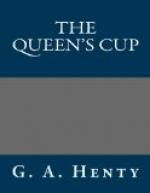In the evening the reinforcements arrived, bringing up the total force to 5,000. When the orders were issued, the officers of the ——th found to their intense satisfaction that, as Captain Mallett had thought likely, the 75th was selected to remain in charge of the baggage at the Alumbagh.
The force moved off, early on the morning of the 14th, but, after marching a short distance along the direct road followed by Havelock, struck off to the right, and, keeping well away from the city, came down upon the summer palace of the Kings of Oude, called the Dilkoosha. It stood on an eminence commanding a view of the whole of the eastern suburbs of the town, and was surrounded by a large park.
As soon as the head of the column approached this, a heavy musketry fire broke out, and it was at once evident that their movements had been watched and the object of their march divined. The head of the column was halted for a few minutes until reinforcements came up. Then they formed into line, the artillery opened on their flanks, and with a cheer the troops advanced to the attack.
“The beggars cannot shoot a bit,” Frank Mallett said to his subaltern, Armstrong. “I expect they are Sepoys, for the Oude tribesmen are said to be good marksmen.”
Keeping up a rolling fire at the loopholes in the walls, the infantry pressed forward. The fire of the enemy slackened as they approached, and they soon forced their way in, some helping their comrades over the wall, others breaking down a gate and so pouring in. A halt was made until the greater portion of the troops came up, and then the advance was continued.
The defenders of the wall had been considerably reinforced by troops stationed round the Palace itself, but they were unable to withstand the British advance, and soon began to retreat towards the city; stopping occasionally where a wall or building offered facilities for defence, but never waiting long enough for the British to get at them. In two hours all had been driven down the hill to the Martiniere College. Here again they made a stand, but were speedily driven out, and chased through the garden and park of the college, and thence across the canal into the streets of the town. Here the pursuit ceased, the ——th being told off to hold the Martiniere as an advanced position. Sir Colin established his headquarters at the Dilkoosha, the rest of the troops bivouacking around it or on the slope of the hill between it and the college.
After seeing that the men were comfortable, and getting some food, most of the officers gathered on the flat roof of the college, whence a fine view was obtainable over the town. The Residency had been already pointed out to them, and the British flag could be seen floating above it. Several very large buildings, surrounded for the most part with walled gardens, rose above the low roofs of the native houses in the intervening space.
“The way is pretty open. A good deal of the ground seems to be occupied with gardens, and most of the houses are so small that they could not hold many men.”




